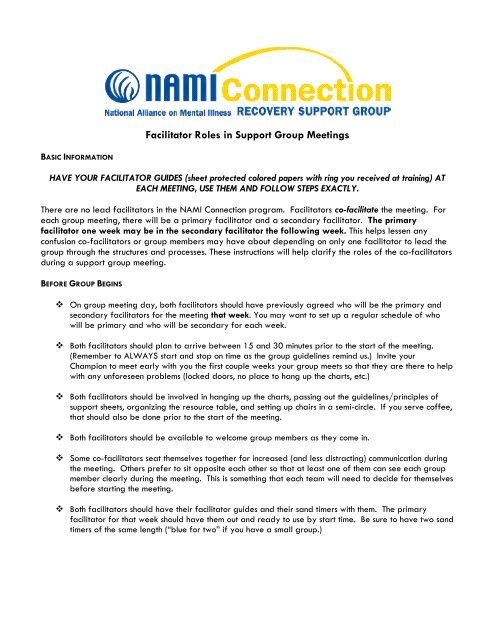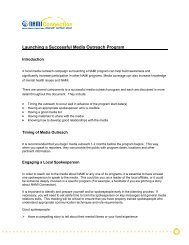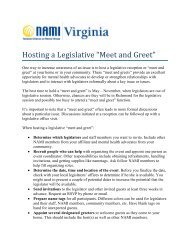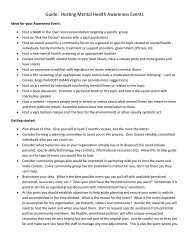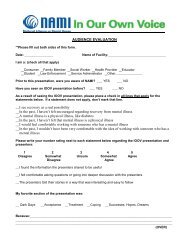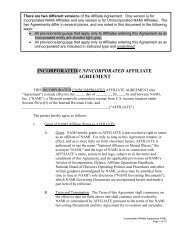Facilitator Roles in Support Group Meetings
Facilitator's Role in Group - NAMI Virginia
Facilitator's Role in Group - NAMI Virginia
Create successful ePaper yourself
Turn your PDF publications into a flip-book with our unique Google optimized e-Paper software.
<strong>Facilitator</strong> <strong>Roles</strong> <strong>in</strong> <strong>Support</strong> <strong>Group</strong> Meet<strong>in</strong>gs<br />
BASIC INFORMATION<br />
HAVE YOUR FACILITATOR GUIDES (sheet protected colored papers with r<strong>in</strong>g you received at tra<strong>in</strong><strong>in</strong>g) AT<br />
EACH MEETING, USE THEM AND FOLLOW STEPS EXACTLY.<br />
There are no lead facilitators <strong>in</strong> the NAMI Connection program. <strong>Facilitator</strong>s co-facilitate the meet<strong>in</strong>g. For<br />
each group meet<strong>in</strong>g, there will be a primary facilitator and a secondary facilitator. The primary<br />
facilitator one week may be <strong>in</strong> the secondary facilitator the follow<strong>in</strong>g week. This helps lessen any<br />
confusion co-facilitators or group members may have about depend<strong>in</strong>g on only one facilitator to lead the<br />
group through the structures and processes. These <strong>in</strong>structions will help clarify the roles of the co-facilitators<br />
dur<strong>in</strong>g a support group meet<strong>in</strong>g.<br />
BEFORE GROUP BEGINS<br />
On group meet<strong>in</strong>g day, both facilitators should have previously agreed who will be the primary and<br />
secondary facilitators for the meet<strong>in</strong>g that week. You may want to set up a regular schedule of who<br />
will be primary and who will be secondary for each week.<br />
Both facilitators should plan to arrive between 15 and 30 m<strong>in</strong>utes prior to the start of the meet<strong>in</strong>g.<br />
(Remember to ALWAYS start and stop on time as the group guidel<strong>in</strong>es rem<strong>in</strong>d us.) Invite your<br />
Champion to meet early with you the first couple weeks your group meets so that they are there to help<br />
with any unforeseen problems (locked doors, no place to hang up the charts, etc.)<br />
Both facilitators should be <strong>in</strong>volved <strong>in</strong> hang<strong>in</strong>g up the charts, pass<strong>in</strong>g out the guidel<strong>in</strong>es/pr<strong>in</strong>ciples of<br />
support sheets, organiz<strong>in</strong>g the resource table, and sett<strong>in</strong>g up chairs <strong>in</strong> a semi-circle. If you serve coffee,<br />
that should also be done prior to the start of the meet<strong>in</strong>g.<br />
Both facilitators should be available to welcome group members as they come <strong>in</strong>.<br />
Some co-facilitators seat themselves together for <strong>in</strong>creased (and less distract<strong>in</strong>g) communication dur<strong>in</strong>g<br />
the meet<strong>in</strong>g. Others prefer to sit opposite each other so that at least one of them can see each group<br />
member clearly dur<strong>in</strong>g the meet<strong>in</strong>g. This is someth<strong>in</strong>g that each team will need to decide for themselves<br />
before start<strong>in</strong>g the meet<strong>in</strong>g.<br />
Both facilitators should have their facilitator guides and their sand timers with them. The primary<br />
facilitator for that week should have them out and ready to use by start time. Be sure to have two sand<br />
timers of the same length (“blue for two” if you have a small group.)
GETTING STARTED<br />
The co-facilitator <strong>in</strong> the primary role for that day should call the group to order on time.<br />
The co-facilitator <strong>in</strong> the secondary role will have pen and paper ready to take notes on data<br />
<strong>in</strong>formation once members beg<strong>in</strong> to check-<strong>in</strong>. (See below for sample sheet you can use to take notes.<br />
Information collected can be easily transferred for data report<strong>in</strong>g).<br />
The primary facilitator should be first to “check-<strong>in</strong>”. Remember to model the one (or two) m<strong>in</strong>ute time<br />
limit. Have pen and paper ready to take notes as group members check <strong>in</strong> so you can address the<br />
issues that come up for each participant. (Aga<strong>in</strong>, the sample sheet can be used to note issues and<br />
prioritize.)<br />
The secondary facilitator, if seated next to the primary, should go next and pass on the sand timer<br />
when done. If co-facilitators are seated opposite each other, the secondary will check <strong>in</strong> when the timer<br />
gets to him or her.<br />
DURING GROUP WORK<br />
Once the group gets <strong>in</strong>to group work, the primary facilitator should move the group along and use the<br />
facilitator guides to work through structures and processes.<br />
The secondary facilitator may, at appropriate times, <strong>in</strong>terject his/her ideas or helpful solutions, but must<br />
remember not to monopolize group time or take the lead from the primary co-facilitator.<br />
Both facilitators should always remember to use “I” statements. Never tell someone what they should or<br />
shouldn’t do.<br />
If needed, the secondary facilitator may escort anyone from the room, if that’s appropriate. Both cofacilitators<br />
can agree on who should go accord<strong>in</strong>g to the circumstances. These should be rare<br />
occurrences, i.e., someone is distract<strong>in</strong>g to the group or someone rema<strong>in</strong>s emotional or suicidal after the<br />
structures and processes have been used.<br />
The secondary facilitator can keep track of time and signal the co-facilitator <strong>in</strong> the primary role when<br />
the meet<strong>in</strong>g is draw<strong>in</strong>g to an end. Decide how and when to signal time. For example, if the primary<br />
facilitator has not started to close the group by five m<strong>in</strong>utes prior to the end of the group, the<br />
secondary facilitator can sign a “T” with his/her hands to <strong>in</strong>dicate time to wrap up. Make sure the plan<br />
works for both of you.<br />
The primary facilitator will conclude the meet<strong>in</strong>g on an “up” note.<br />
AFTER THE MEETING<br />
Remove charts and table, pack up resources, and arrange the room as you found it. Keep the landlord<br />
happy.<br />
If there is no storage space <strong>in</strong> your group location, both facilitators may want to keep their charts,<br />
supplies and resources <strong>in</strong> their cars to ensure the group will always have them.<br />
Debrief one another and discuss who’s do<strong>in</strong>g what the follow<strong>in</strong>g week.<br />
Report your data - either by postcard or via email. After you transfer your data from your notes,<br />
destroy your notes. There should not be a record of the names of participants. You will want to decide<br />
who will be responsible for report<strong>in</strong>g either by the role they take each week OR the one person who<br />
tends to do a great job with details. Set up a plan that works for you and then stick to it.
Meet<strong>in</strong>g Notes<br />
NOTE: Please use identifiers not names <strong>in</strong> the first column (e.g. green shirt, glasses, etc. or<br />
chair number 1, 2, 3, etc.)<br />
<strong>Facilitator</strong> Names: __________________________________________<br />
Date: _____________________________________________________<br />
Person<br />
(<strong>in</strong>dentifier) tear<br />
off and destroy<br />
after meet<strong>in</strong>g<br />
M/F<br />
Age<br />
(approx.)<br />
Diagnosis Description Priority<br />
To assure confidentiality, it is important that you tear off and destroy the “person” column immediately<br />
after your meet<strong>in</strong>g to avoid hav<strong>in</strong>g anyth<strong>in</strong>g that could be used to identify group members.


